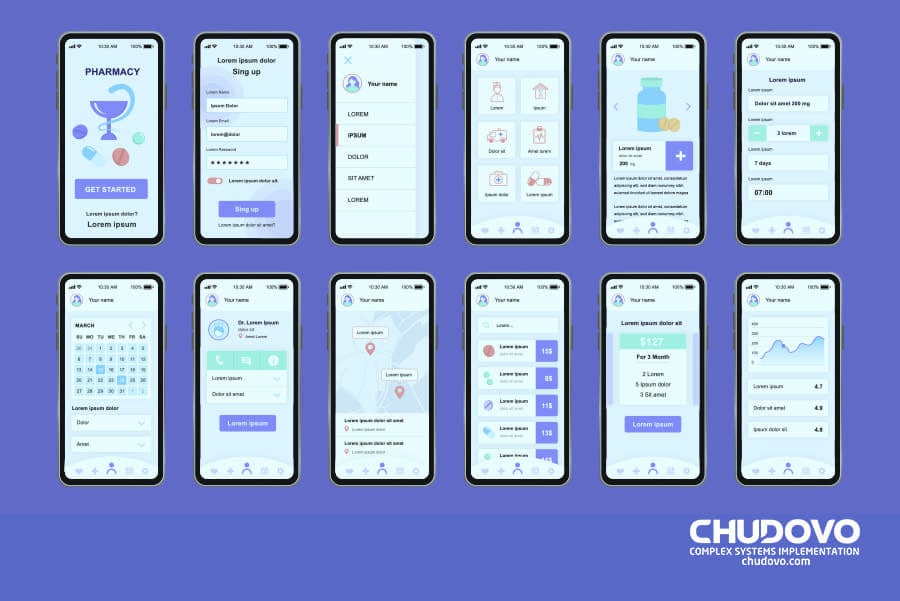Enable Progress in Healthcare: The White-Label Telemedicine App Solution
Telemedicine is a rapidly growing industry, and building a white label solution can be a profitable venture. With the rise of remote work and the COVID-19 pandemic, telemedicine has gained significant attention and popularity. People can now easily consult doctor and healthcare professionals from the comfort of their own homes. This concept has led to an increased demand for telemedicine solutions, making it a lucrative market to invest in.
Table of content
- What Is a White Label Telemedicine App?
- Features White Label Telemedicine App
- Pros Custom Telehealth App
- Step By Steps Guide to Developing a White Label Telemedicine Solution
- Practices Healthcare Custom Solutions Development
- The Advantages of the Performance of the Dedicated Team
- Price White Label Telemedicine App
- Conclusion
- FAQ

What Is a White Label Telemedicine App?
A white label telemedicine app is a digital platform that allows healthcare providers to offer virtual consultations and medical services to patients remotely. These mobile apps are branded and customized to fit the specific needs and requirements of healthcare providers, allowing them to offer telemedicine services under their own brand names.
White label telemedicine apps have become increasingly popular in recent years, especially with the rise of telemedicine and the need for remote healthcare services. According to a report by Mordor Intelligence, the global telemedicine market is expected to grow at a compound annual growth rate (CAGR) of 20.5% by 2028. This growth is driven by factors such as the increasing prevalence of chronic diseases, the need for better healthcare access in rural areas, and the growing demand for remote healthcare services.
Features White Label Telemedicine App
Telemedicine is revolutionizing the healthcare industry by providing patients with remote access to medical care and healthcare professionals. A white label telemedicine app is a customizable platform that allows healthcare providers to offer telehealth services under their brand name. Here are five essential features custom telehealth app of a white label telemedicine app:
1. Video Consultations
One of the primary features of a telemedicine app is video consultations. These consultations allow patients to connect with healthcare providers from the comfort of their homes, which is especially beneficial for those who have mobility issues, live in remote areas, or have busy schedules. In addition to being convenient, video consultations can also be a more cost-effective option for patients who would otherwise need to travel to see their healthcare providers.
To ensure that patients have a positive and effective video consultation experience, the app should have a user-friendly video interface. This interface should be easy to navigate and should allow for high-quality, secure video calls. Some features that could be included in the interface are the ability to adjust the video and audio settings, the ability to share documents or images during the call, and the ability to schedule follow-up appointments with healthcare providers.
2. Electronic Health Records (EHR) Integration
An Electronic Health Record (EHR) system is an essential tool that healthcare providers use to store, manage, and access patient information. It allows providers to access medical records, patient histories, and other critical information quickly and efficiently, ultimately improving patient care. EHR systems have revolutionized the way healthcare professionals work, enabling them to provide better quality care to their patients.
In addition, a white label telemedicine app is a valuable tool that healthcare providers can use to conduct virtual consultations with their patients. By integrating with EHR systems, healthcare providers can access medical records and update them in real-time during the virtual consultation. This integration ensures that healthcare providers have access to the most up-to-date information about their patients, allowing them to make informed decisions about their care.
Moreover, the integration of EHR systems with a white label telemedicine app not only improves the quality of patient care but also increases the efficiency of healthcare delivery. By eliminating the need for patients to travel to healthcare facilities physically, virtual consultations save time and resources for both patients and healthcare providers. This efficiency can lead to cost savings for healthcare providers and improved patient satisfaction.
3. Appointment Scheduling and Reminders
Scheduling and managing appointments is a crucial task for healthcare providers that can be quite challenging, especially in the current healthcare landscape. Therefore, it is essential for a telemedicine app to have an appointment scheduling and reminder feature that can help healthcare providers manage their schedules efficiently and effectively.
The appointment scheduling and reminder feature should be designed to cater to the specific needs and requirements of healthcare providers. For example, it should allow them to schedule appointments based on their availability and preferences, and it should also provide them with the flexibility to reschedule or cancel appointments if required. Additionally, the feature should enable healthcare providers to view and manage their schedules easily, so they can keep track of their appointments and avoid double-booking or overbooking.
In addition to healthcare providers, patients should also benefit from the appointment scheduling and reminder feature. Patients should receive timely reminders about their upcoming appointments, which can help them plan and prepare for their virtual consultations. This can include reminders to take any necessary medications or tests before the appointment, as well as reminders to log in to the telemedicine app at the scheduled time.
4. Prescriptions and Referrals
A telemedicine app should not only allow healthcare providers to issue prescriptions and referrals electronically, but also provide a seamless experience for both healthcare providers and patients. By eliminating the need for patients to visit a physical clinic, telemedicine apps can greatly improve access to healthcare service, especially for those who live in remote areas or have limited mobility. In addition, telemedicine apps can save time and resources by reducing the number of in-person consultations needed for routine medical issues.
In addition, telemedicine apps can improve healthcare provider efficiency by allowing them to see more patients in less time. Healthcare providers can conduct virtual consultations from anywhere, at any time, which can help them manage their busy schedules and reduce waiting times for patients. Telemedicine apps can also help healthcare providers collaborate with other specialists and healthcare professionals, which can improve the quality of care and patient outcomes.
5. Secure Messaging
Secure messaging is an essential feature for a telemedicine app, allowing healthcare providers and patients to communicate outside of virtual consultations. In addition to HIPAA-compliant messaging, the app should also have a user-friendly interface that allows patients to easily communicate with their healthcare providers. This messaging system would ensure that patients do not have to rely on phone calls or emails, but can instead have direct access to their healthcare provider. Additionally, the messaging system should be customizable, allowing healthcare providers to tailor messages to specific patients, ensuring that the communication is as effective as possible. Another important feature that the messaging system should have is the ability to send attachments, such as medical records, test results, or other important documents. This would allow patients to easily share information with their healthcare provider while maintaining the confidentiality of their information.
Pros Custom Telehealth App
A custom telehealth app can provide numerous benefits for healthcare providers, patients, and the overall healthcare system. Here are some of the major pros white label telemedicine app :
- Improved patient access to healthcare
With a custom telehealth app, patients can easily connect with healthcare providers from anywhere, at any time. This can be especially helpful for patients who live in rural or remote areas, or those who have difficulty traveling to appointments.
- Increased efficiency and productivity
A custom telehealth app can streamline the healthcare process, making it faster and more efficient for both patients and providers. This can result in a higher volume of patients being seen and treated, reducing wait times and increasing overall productivity.
- Cost savings
Мobile telehealth can reduce healthcare costs by eliminating the need for travel, reducing the number of missed appointments, and preventing unnecessary hospitalizations. In addition, telehealth visits are often less expensive than in-person visits.
- Improved patient outcomes
Telehealth can improve patient outcomes by allowing for more frequent monitoring and follow-up care, leading to better management of chronic conditions and fewer complications.
- Increased patient satisfaction
Telehealth can improve patient satisfaction by providing greater convenience and access to care, as well as reducing wait times and travel time.
Step By Steps Guide to Developing a White Label Telemedicine Solution
If you’re considering developing a white label telemedicine solution, here is a step-by-step guide to help you get started. With these steps, you’ll be able to create a telemedicine solution that meets your needs and those of your clients. By following these steps, you’ll be able to provide a high-quality telemedicine service that can help people around the world access healthcare easily and affordably.
Step 1: Developing the MVP
The first step in building your product is to develop a minimum viable product (MVP). An MVP is a prototype that has just enough features to satisfy early customers and to provide feedback for future product development.
By MVP development you can use no-code and low-code platforms which are designed to help you build functional products quickly and easily, without having to write code manually. These platforms provide a wide range of tools and resources to help you create a product that meets your requirements.
Step 2: Adding Advanced Features
Once you have the MVP in place, you can start adding advanced features. These modules may include AI-powered diagnosis, integration with electronic health records (EHRs), and real-time translation, among others. By integrations AI-powered diagnosis, patients can have a more accurate diagnosis, which in turn leads to better treatment. Integration with electronic health records (EHRs) allows doctors and other healthcare professionals to have access to important patient information, which can improve diagnostic accuracy and treatment outcomes. Real-time translation can help healthcare providers communicate with patients who speak different languages, which is especially important in multilingual communities.
You can use low code platforms to add these features quickly. Low-code platforms use drag-and-drop interfaces and visual modeling to enable users to build applications with little to no coding required. With low-code platforms, developers can create high-quality, complex applications much faster than they would be able to with traditional coding methods. This means that healthcare providers can quickly add advanced features to their applications, without having to wait for a software development process.
Step 3: Designing the User Interface
The user interface (UI) is a critical aspect of any telemedicine software as it allows doctors and patients to interact and communicate with each other. A well-designed UI can reduce the learning curve for patients who are not familiar with the technology, and it can also increase the efficiency of the healthcare provider. When designing the UI, it is essential to ensure that it is easy to navigate, intuitive, and user-friendly.
One way to achieve this is by using no-code platforms where you can drag and drop components to create the UI without having to write any code. However, if you need more advanced features or customization, you can use low-code platforms to integrate the UI with your telemedicine solution. By doing so, you can create a robust and comprehensive telemedicine solution that meets the needs of both healthcare providers and patients.
Step 4: Testing
After the solution is complete, it is essential to test it thoroughly to ensure that it meets all the requirements and specifications. This includes both manual and automated testing to check for any bugs, glitches, and other potential issues that may arise. Manual testing can be performed by a team of testers who will use the solution and provide feedback on its functionality, usability, and overall performance. Automated testing tools can also be used to run various tests to check for issues such as load testing, stress testing, and security testing. It is necessary to test the application, starting from authentication, starting with the definition of the morning and chat possibilities.
Once the testing is complete and all issues have been resolved, the solution is ready for release, and it can be deployed to the production environment. It is important to note that even after the release, the solution should be monitored continuously to ensure that it continues to function correctly and to identify any issues that may arise in the future.
Step 5: Hosting on the Cloud
Telemedicine solutions require significant processing power and bandwidth to ensure smooth and efficient operation. This is because telemedicine involves a lot of data transfer between healthcare professionals and patients, and this data needs to be processed and analyzed quickly. To ensure that telemedicine solutions are always available and functioning optimally, cloud hosting is often the best option.
Cloud hosting provides a range of benefits for telemedicine solutions. Firstly, it allows you to scale the solution as needed, which means that you can easily add more processing power or bandwidth to ensure that the solution can handle increasing demand. This is particularly important for telemedicine solutions, as demand can fluctuate rapidly depending on a range of factors.
Step 6: Release and Support
Once the solution is deployed to the cloud, it is ready to be released. However, it is important to provide ongoing support to users to ensure they can use the solution effectively. Consider using low-code platforms to create an intuitive support portal, where users can easily access relevant information and get help with any issues they encounter. This portal can include FAQs, step-by-step guides, and even a community forum where users can share their experiences and help each other troubleshoot. Providing comprehensive support not only helps users get the most out of the solution, but it also builds trust and loyalty, which can lead to long-term success. You also need to remember to release updates to improve the system and remove possible bugs.
Practices Healthcare Custom Solutions Development
Here are some best practices for building a custom telehealth platform:
- Understand the needs of the healthcare companies and its patients before beginning any development.
- Ensure that the solution meets all regulatory requirements and standards for healthcare data privacy and security.
- Use Agile development methodologies to ensure that the solution is flexible and can adapt to changing needs.
- Collaborate with healthcare professionals to ensure that the solution is user-friendly and meets the needs of healthcare providers and patients.
- Test the solution thoroughly before deployment to ensure that it is reliable and meets all functional requirements.
- Provide ongoing support and maintenance to ensure that the solution continues to meet the needs of the healthcare organization and its patients.
By following these best practices, healthcare organizations can develop modular solutions that are effective, efficient, and meet the needs of their patients and healthcare providers.
The Advantages of the Performance of the Dedicated Team
When it comes to achieving business objectives, many firms prefer to operate with dedicated teams. A dedicated team is a group of professionals who work exclusively on a specific project or task. They are committed to the project’s success and work together to ensure that the project is completed on time and within budget. In this document, we will discuss the advantages of the performance of a dedicated team.
1. Increased Efficiency
Dedicated teams are more efficient than traditional teams because they are solely focused on one product. They do not have to worry about juggling multiple projects or tasks, which can lead to distractions and delays. With a dedicated team, all team members are working towards a common goal, and there is a clear sense of direction and purpose.
2. Improved Communication
Dedicated teams often have better communication than traditional teams. Since all team members are working on the same project, they are in constant communication with each other. This helps to reduce misunderstandings and ensures that everyone is on the same page. In addition, dedicated teams often have a project manager who acts as a liaison between the team and stakeholders, ensuring that communication is always clear and concise.
3. Greater Accountability
Dedicated teams are more accountable than traditional teams. Since they are solely responsible for a project’s success, team members are more likely to take ownership of their work and ensure that it is completed to the best of their abilities. With a dedicated team, there is also a clear chain of command, which helps to ensure that everyone knows what is expected of them.
4. Increased Flexibility
Dedicated teams are often more flexible than traditional teams. Since they are solely focused on one project, they can quickly adapt to changes in project requirements or scope. They can also work outside of traditional business hours if needed, which can help to speed up project timelines.

Price White Label Telemedicine App
Telemedicine has become increasingly popular in recent years, especially with the COVID-19 pandemic. Many healthcare providers are turning to telemedicine apps to offer remote medical consultations to patients from the comfort of their homes. White label telemedicine apps have become a popular choice for healthcare providers who want to offer a branded telemedicine app to their patients.
The price of a white label telemedicine app can vary depending on several factors such as the features, the level of customization, and the number of users. However, the average cost of a white label telemedicine app is between $10,000 and $50,000. This cost includes the custom development of the app, testing, and deployment to the app stores.

Certified engineers
Convenient rates
Fast start
Profitable conditions
Agreement with
EU company
English and German
speaking engineers
Some telemedicine app providers offer different pricing models, such as a monthly subscription fee or a pay-per-use model. The monthly subscription fee can range from $100 to $1,000 per month, depending on the number of users and the features included. The pay-per-use model charges a fee for each telemedicine consultation, and the fee can range from $20 to $150 per consultation.
The price of a white label telemedicine app can vary depending on several factors, but the average cost is between $10,000 and $50,000. Healthcare providers should consider the long-term cost savings and benefits of telemedicine when making a decision about investing in a white label telemedicine app.
Conclusion
In conclusion, a white label telemedicine app can provide numerous benefits for healthcare providers and patients alike. With features such as video consultations, EHR integration, appointment scheduling and reminders, prescriptions and referrals, and secure messaging, telemedicine apps can improve access to healthcare, increase efficiency, reduce costs, and improve patient outcomes. Developing a custom telemedicine solution using modular solutions can be achieved in just a matter of months, with the use of no-code and low-code platforms to pick from. Additionally, the principles of Agile development, collaboration with healthcare professionals, and comprehensive testing and ongoing support can help ensure that the solution meets the needs of healthcare providers and patients. Finally, a dedicated team of professionals is essential for the successful development and deployment of a white label telemedicine app solution, just as a well-designed CRM development is fundamental for any business.
FAQ
The answers to the question can help to better understand the telemedicine app concept by development. After reading the answers to frequently asked questions, you will be able to draw a conclusion about the need for such development.
What is a white-label telemedicine app solution?
A white-label telemedicine app solution is a customizable platform that healthcare providers can use to offer telemedicine services to their patients. The solution is “white-label” because the provider can brand it with their own logo and other design elements to make it look like their own app. The provider can also customize the features and functionality to meet their specific needs.
How can a white-label telemedicine app solution help healthcare providers?
A can help healthcare providers by allowing them to offer telemedicine services to their patients. This can help them reach patients who may not be able to come into the office due to distance, mobility issues, or other factors. The app can also help providers streamline their operations by allowing them to schedule appointments, conduct video consultations, and manage patient records all in one place.
What are the benefits of using a white-label telemedicine app solution?
There are several benefits to using a white-label telemedicine app solution. First, it can help healthcare providers increase their revenue by reaching more patients. Second, it can improve patient satisfaction by offering convenient, accessible healthcare services. Third, it can help providers save time and money by reducing administrative tasks and allowing them to focus on providing quality care.
If you need highly qualified healthcare app developers at the right price for your project, contact us now!




